More details
Penumbral Magnitude: 2.07253 (207.253%)
Umbral Magnitude: 1.11164 (111.164%)
Gamma: -0.41732
Epsilon: 0°25’24.96”
Greatest Eclipse = 1968 Apr 13 at 04:47:22.2 UTC
Ecliptic Opposition = 1968 Apr 13 at 04:51:39.2 UTC
Equatorial Opposition = 1968 Apr 13 at 05:09:48.0 UTC
Sun’s Equatorial Right Ascension = 1.439h
Sun’s Equatorial Declination = +9.06°
Sun’s Diameter = 1913.8 arcseconds
Sun’s Equatorial Horizontal Parallax = 17.6 arcseconds
Moon’s Equatorial Right Ascension = 13.426h
Moon’s Equatorial Declination = -9.44°
Moon’s Diameter = 1991.6 arcseconds
Moon’s Equatorial Horizontal Parallax = 7309.4 arcseconds
Earth’s Shadow’s Equatorial Right Ascension = 13.439h
Earth’s Shadow’s Equatorial Declination = -9.06°
Earth’s Penumbral Shadow’s Diameter = 9313.92 arcseconds
Earth’s Umbral Shadow’s Diameter = 5486.4 arcseconds
Saros 131 (31 of 72), Descending Node
P1: 1968 Apr 13 (Sat) at 02:12:33.3 UTC
U1: 1968 Apr 13 (Sat) at 03:10:18.4 UTC
U2: 1968 Apr 13 (Sat) at 04:23:07.6 UTC
Greatest: 1968 Apr 13 (Sat) at 04:47:22.2 UTC
U3: 1968 Apr 13 (Sat) at 05:11:38.3 UTC
U4: 1968 Apr 13 (Sat) at 06:24:28.0 UTC
P4: 1968 Apr 13 (Sat) at 07:22:09.1 UTC
Eclipse Durations
The total duration of the eclipse was 5 hours, 9 minutes and 35.8 seconds.
The duration of the partial phases was 2 hours, 25 minutes and 38.9 seconds.
The duration of totality was 48 minutes and 30.7 seconds.
Saros series
It is the second total lunar eclipse of the series.
Lunar Saros series 131, has 72 lunar eclipses. Solar Saros 138 interleaves with this lunar saros with an event occurring every 9 years 5 days alternating between each saros series.
This eclipse series began in AD 1427 with a partial eclipse at the southern edge of the Earth's shadow when the Moon was close to its descending node. Each successive Saros cycle, the Moon's orbital path is shifted northward with respect to the Earth's shadow, with the first total eclipse occurring in 1950. For the following 252 years, total eclipses occur, with the central eclipse being predicted to occur in 2078. The first partial eclipse after this is predicted to occur in the year 2220, and the final partial eclipse of the series will occur in 2707. The total lifetime of the lunar Saros series 131 is 1280 years. Solar Saros 138 interleaves with this lunar saros with an event occurring every 9 years 5 days alternating between each saros series.
Because of the ⅓ fraction of days in a Saros cycle, the visibility of each eclipse will differ for an observer at a given fixed locale. For the lunar Saros series 131, the first total eclipse of 1950 had its best visibility for viewers in Eastern Europe and the Middle East because mid-eclipse was at 20:44 UT. The following eclipse in the series occurred approximately 8 hours later in the day with mid-eclipse at 4:47 UT, and was best seen from North America and South America. The third total eclipse occurred approximately 8 hours later in the day than the second eclipse with mid-eclipse at 12:43 UT, and had its best visibility for viewers in the Western Pacific, East Asia, Australia and New Zealand. This cycle of visibility repeats from the initiation to termination of the series, with minor variations. Solar Saros 138 interleaves with this lunar saros with an event occurring every 9 years 5 days alternating between each saros series.
Lunar Saros series 131, repeating every 18 years and 11 days, has a total of 72 lunar eclipse events including 57 umbral lunar eclipses (42 partial lunar eclipses and 15 total lunar eclipses). Solar Saros 138 interleaves with this lunar saros with an event occurring every 9 years 5 days alternating between each saros series.
| Greatest | First |
|---|

The greatest eclipse of the series will occur on 2094 Jun 28, lasting 102 minutes. [1] | Penumbral | Partial | Total | Central |
|---|
| 1427 May 10 | 1553 July 25 | 1950 Apr 2 | 2022 May 16 |
| Last |
|---|
| Central | Total | Partial | Penumbral |
|---|
| 2148 Jul 31 | 2202 Sep 3 | 2563 Apr 9 | 2707 Jul 7 |
Inex series
The inex series repeats eclipses 20 days short of 29 years, repeating on average every 10571.95 days. This period is equal to 358 lunations (synodic months) and 388.5 draconic months. Saros series increment by one on successive Inex events and repeat at alternate ascending and descending lunar nodes.
This period is 383.6734 anomalistic months (the period of the Moon's elliptical orbital precession). Despite the average 0.05 time-of-day shift between subsequent events, the variation of the Moon in its elliptical orbit at each event causes the actual eclipse time to vary significantly. It is a part of Lunar Inex series 35.
Half-Saros cycle
A lunar eclipse will be preceded and followed by solar eclipses by 9 years and 5.5 days (a half saros). [2] This lunar eclipse is related to two annular solar eclipses of Solar Saros 138.

A total lunar eclipse took place on 3 March 2007, the first of two eclipses in 2007. The moon entered the penumbral shadow at 20:18 UTC, and the umbral shadow at 21:30 UTC. The total phase lasted between 22:44 UTC and 23:58 UTC with a distinctive brick-red shade. The moon left the umbra shadow at 01:11 UTC and left the penumbra shadow at 02:24 UTC 2007-03-04. The second lunar eclipse of 2007 occurred on 28 August.

A total lunar eclipse occurred on February 20 and February 21, 2008. It was visible in the eastern evening sky on February 20 for all of North and South America, and on February 21 in the predawn western sky from most of Africa and Europe. Greatest Eclipse occurring on Thursday, February 21, 2008, at 03:26:03 UTC, totality lasting 49 minutes and 45.6 seconds.

A total lunar eclipse took place on May 4, 2004, the first of two total lunar eclipses in 2004, the second being on October 28, 2004.

A total lunar eclipse took place on Wednesday 8 October 2014. It is the second of two total lunar eclipses in 2014, and the second in a tetrad. Other eclipses in the tetrad are those of 15 April 2014, 4 April 2015, and 28 September 2015. Occurring only 2.1 days after perigee, the Moon's apparent diameter was larger, 1960.6 arcseconds.

A total lunar eclipse will take place on May 26, 2040. The northern limb of the moon will pass through the center of the Earth's shadow. This is the second central lunar eclipse of Saros series 131.

A total lunar eclipse occurred on 15–16 May 2022, the first of two total lunar eclipses in 2022. The event occurred near lunar perigee; as a result, this event was referred to some in media coverage as a "super flower blood moon" and elsewhere as a "super blood moon", a supermoon that coincides with a total lunar eclipse. This was the longest total lunar eclipse visible from nearly all of North America since August 17, 1989 until the next eclipse on November 8.
A total lunar eclipse took place on Friday, August 6, 1971, the second of two total lunar eclipses in 1971. A dramatic total eclipse lasting 1 hour, 39 minutes and 24.8 seconds plunged the full Moon into deep darkness, as it passed right through the centre of the Earth's umbral shadow. While the visual effect of a total eclipse is variable, the Moon may have been stained a deep orange or red colour at maximum eclipse. This was a great spectacle for everyone who saw it. The partial eclipse lasted for 3 hours, 35 minutes and 31.9 seconds in total. Occurring only 2.2 days before perigee, the Moon's apparent diameter was 3.6% larger than average and the moon passed through the center of the Earth's shadow.
A total lunar eclipse took place on Thursday, April 24, 1986, the first of two total lunar eclipses in 1986, the second being on October 17, 1986. The Moon was plunged into darkness for 1 hour, 3 minutes and 34.8 seconds, in a deep total eclipse which saw the Moon 20.217% of its diameter inside the Earth's umbral shadow. The visual effect of this depends on the state of the Earth's atmosphere, but the Moon may have been stained a deep red colour. The partial eclipse lasted for 3 hours, 18 minutes and 46.8 seconds in total. The Moon was just 1.2 days before perigee, making it 5.3% larger than average.
A penumbral lunar eclipse took place on Tuesday, January 20, 1981, the first of two lunar eclipses in 1981. In a rare total penumbral eclipse, the entire Moon was partially shaded by the Earth, and the shading across the Moon should have been quite visible at maximum eclipse. The penumbral phase lasted for 4 hours and 24 minutes in all, though for most of it, the eclipse was extremely difficult or impossible to see. The moon's apparent diameter was larger because the eclipse occurred 5.2 days after perigee.
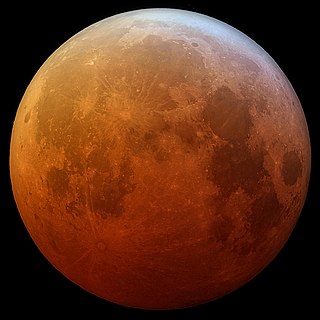
A total lunar eclipse occurred on 21 January 2019 UTC. For observers in the Americas, the eclipse took place between the evening of Sunday, 20 January and the early morning hours of Monday, 21 January. For observers in Europe and Africa, the eclipse occurred during the morning of 21 January. The Moon was near its perigee on 21 January and as such can be described as a "supermoon".

A total lunar eclipse took place on Sunday, April 2, 1950. This was the first total lunar eclipse of Saros cycle 131.
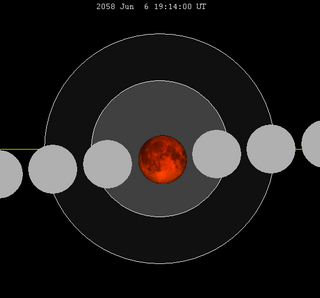
A total lunar eclipse will take place on June 6, 2058. The moon will pass through the center of the Earth's shadow.

A total lunar eclipse will take place on June 17, 2076. The moon will pass through the center of the Earth's shadow. While the visual effect of a total eclipse is variable, the Moon may be stained a deep orange or red color at maximum eclipse. With a gamma value of only −0.0452 and an umbral eclipse magnitude of 1.7943, this is the second greatest eclipse in Saros series 131 as well as the largest and darkest lunar eclipse between June 26, 2029 and June 28, 2094. Overall, it will be the third largest and darkest lunar eclipse of the 21st century. While it will have similar values to the lunar eclipse of July 16, 2000, totality will not last over 106 minutes due to the moon's relatively large apparent size as seen from Earth and greater speed in its elliptical orbit. Totality's expected to last 100 minutes 34 seconds from 9:11:39 to 10:52:15 with the greatest point at 10:01:57 UTC.
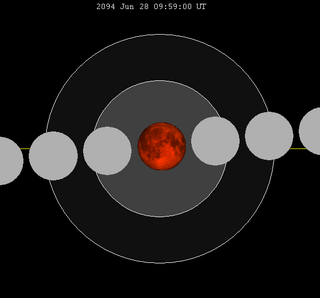
A total lunar eclipse will take place on June 28, 2094. The moon will pass through the center of the Earth's shadow. While the visual effect of a total eclipse is variable, the Moon may be stained a deep orange or red color at maximum eclipse. With a gamma value of only 0.0288 and an umbral eclipse magnitude of 1.8234, this is the greatest eclipse in Saros series 131 as well as the second largest and darkest lunar eclipse of the 21st century.

A partial lunar eclipse took place on Tuesday, March 22, 1932. It was the first of 2 nearly total eclipses. The second lunar eclipse of such happened on September 14. This lunar eclipse of Saros cycle 131 preceded the first total eclipse on April 2, 1950.
A partial lunar eclipse took place on Thursday, March 12, 1914.
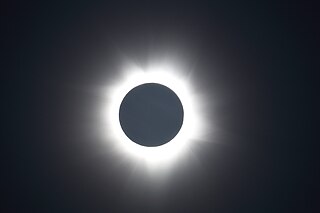
A total solar eclipse took place on 13–14 November 2012 (UTC). Because it crossed the International Date Line it began in local time on November 14 west of the date line over northern Australia, and ended in local time on November 13 east of the date line near the west coast of South America. Its greatest magnitude was 1.0500, occurring only 12 hours before perigee, with greatest eclipse totality lasting just over four minutes. A solar eclipse occurs when the Moon passes between Earth and the Sun, thereby totally or partly obscuring the image of the Sun for a viewer on Earth. A total solar eclipse occurs when the Moon's apparent diameter is larger than the Sun's, blocking all direct sunlight, turning day into darkness. Totality occurs in a narrow path across Earth's surface, with the partial solar eclipse visible over a surrounding region thousands of kilometres wide.
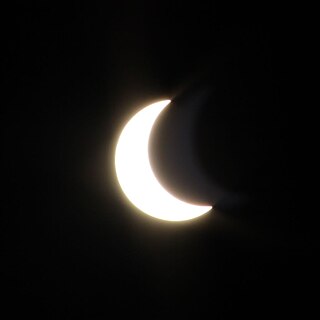
An annular solar eclipse took place on February 26, 2017. A solar eclipse occurs when the Moon passes between Earth and the Sun, thereby totally or partly obscuring the image of the Sun for a viewer on Earth. An annular solar eclipse occurs when the Moon's apparent diameter is smaller than the Sun's, blocking most of the Sun's light and causing the Sun to look like an annulus (ring). An annular eclipse appears as a partial eclipse over a region of the Earth thousands of kilometres wide. Occurring only 4.7 days before perigee, the Moon's apparent diameter was larger. The moon's apparent diameter was just over 0.7% smaller than the Sun's.

An annular solar eclipse occurred on December 14, 1955. A solar eclipse occurs when the Moon passes between Earth and the Sun, thereby totally or partly obscuring the image of the Sun for a viewer on Earth. An annular solar eclipse occurs when the Moon's apparent diameter is smaller than the Sun's, blocking most of the Sun's light and causing the Sun to look like an annulus (ring). An annular eclipse appears as a partial eclipse over a region of the Earth thousands of kilometres wide.

A total solar eclipse occurred on June 8–9, 1956. A solar eclipse occurs when the Moon passes between Earth and the Sun, thereby totally or partly obscuring the image of the Sun for a viewer on Earth. A total solar eclipse occurs when the Moon's apparent diameter is larger than the Sun's, blocking all direct sunlight, turning day into darkness. Totality occurs in a narrow path across Earth's surface, with the partial solar eclipse visible over a surrounding region thousands of kilometres wide. It began near sunrise over New Zealand on June 9 (Saturday), and ended west of South America on June 8 (Friday).





































































